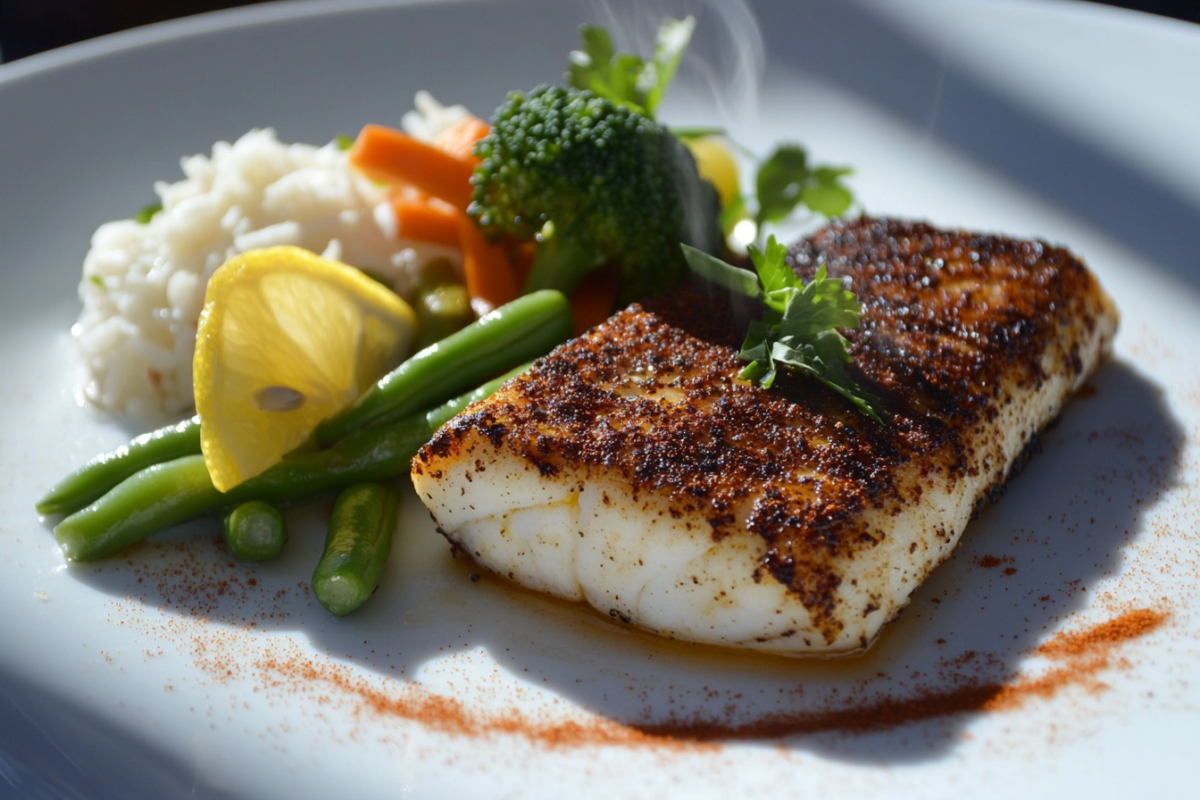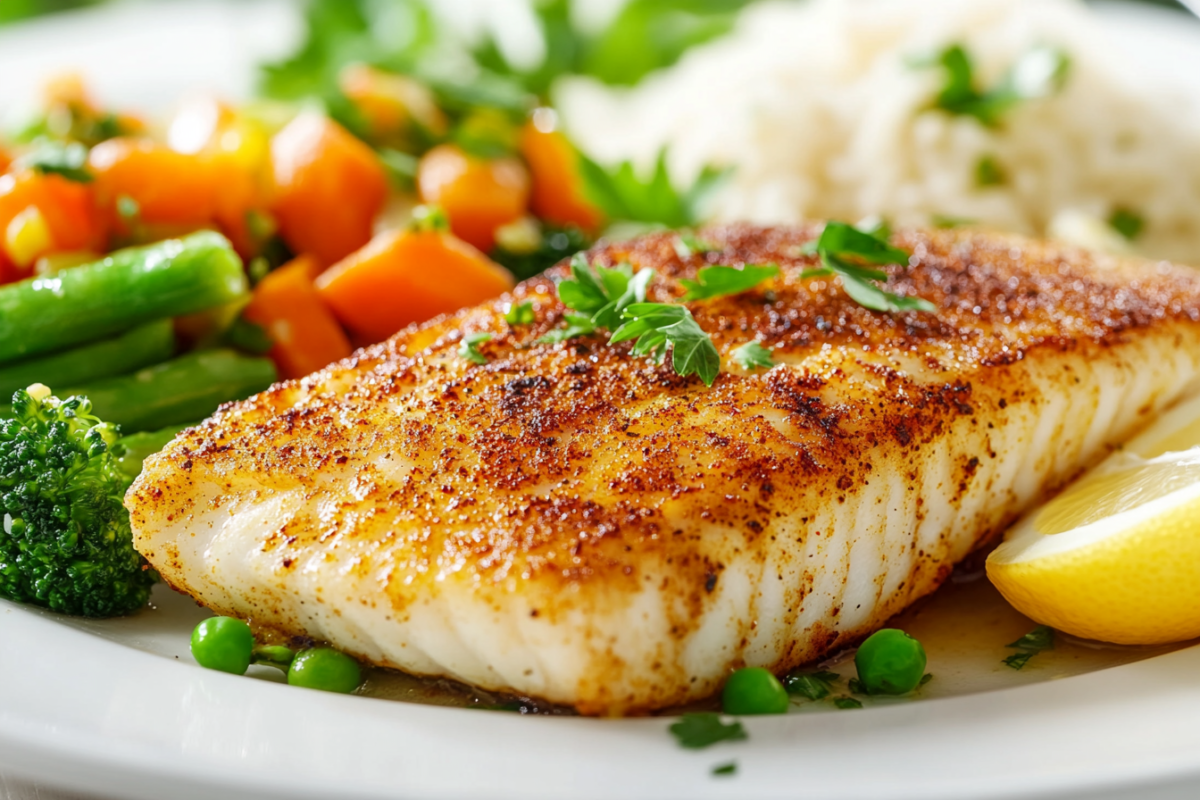If you’re looking for a delicious, easy-to-make fish dish, then the blackened grouper recipe is a fantastic choice. This flavorful dish is perfect for anyone who loves bold spices and crispy fish. Whether you’re a seasoned chef or just beginning to experiment with seafood, making blackened grouper is a straightforward and rewarding cooking experience.
The key to this recipe lies in the unique cooking method: blackening, which gives the grouper its signature charred and flavorful crust. This method infuses the fish with aromatic spices, making it irresistible to anyone who loves rich, spicy dishes. Unlike other fish preparations, blackened grouper involves cooking the fillets at high heat to create a crispy, smoky exterior while keeping the inside tender and juicy.
What is Blackened Grouper?
When you think of seafood dishes, blackened grouper is likely a standout option. It’s a classic recipe that brings out the fish’s natural flavors, while adding a smoky, spicy kick from the blackening method. But what exactly does “blackened” mean? Simply put, it’s a cooking technique that involves coating the fish with a blend of spices and then searing it in a very hot skillet, typically cast iron. This high heat causes the seasoning to “blacken,” creating a flavorful crust while keeping the fish tender and moist inside.
This method isn’t limited to just grouper. It’s commonly used for other fish, such as snapper or mahi-mahi, but the thick texture of grouper makes it a perfect match for blackening. Grouper is mild yet firm, with a subtle sweetness that pairs wonderfully with the strong spices in blackened seasoning. The result is a contrast of rich flavors that will surely make your taste buds dance!
Why Choose Grouper for Blackening?
Grouper is one of the best fish for blackened dishes due to its firm texture and mild flavor. This fish holds up well when cooked at high heat, ensuring that you get the perfect crispy crust without the fillet falling apart. Unlike delicate fish like flounder or tilapia, grouper’s meaty texture provides a great base for the bold, spicy seasoning typically used in blackened recipes.
Additionally, grouper’s mild flavor makes it incredibly versatile. It doesn’t overpower the spices, but rather complements them, allowing the seasoning to shine. If you prefer a fish that’s a bit bolder in flavor, mahi-mahi or snapper would also work well, but grouper remains a classic for a reason—it’s consistently delicious, hearty, and easy to work with.
A Quick Overview of Blackening Cooking Method
Before diving into the blackened grouper recipe, it’s important to understand the blackening technique itself. Originating from Cajun cuisine, blackening involves seasoning the fish with a mixture of herbs and spices, then cooking it at high heat. The goal is to create a crust that’s crispy, flavorful, and slightly smoky. It’s different from grilling or frying, as the blackened crust forms from the caramelization of the spices and butter, creating a signature dark and spicy surface.
What makes this technique so special is its ability to lock in moisture while adding a deeply satisfying, flavorful exterior. Whether you’re making blackened fish for a quick weeknight dinner or a special occasion, mastering this method will guarantee a dish that’s both visually striking and absolutely delicious.
Ingredients Needed for Blackened Grouper Recipe
Creating the perfect blackened grouper recipe begins with using the right ingredients. The beauty of this dish lies in its simplicity—just a handful of key components are needed to create that irresistible, flavorful crust. Let’s break down the ingredients you’ll need to get started, along with a few optional additions that can enhance the dish.
Essential Ingredients for Blackened Grouper
To make a delicious blackened grouper, the following ingredients are crucial:
- Fresh grouper fillets: Freshness is key when cooking any seafood. Choose firm, white-fleshed grouper fillets for the best results. When shopping for fish, look for fillets that are moist, not slimy, and have a clean, fresh scent. Frozen grouper works as well, but it’s always best to use fresh fish for maximum flavor.
- Blackened seasoning mix: This is where the magic happens! You can either purchase a pre-made blackened seasoning mix or make your own at home. A good blackened seasoning typically includes paprika, cayenne pepper, garlic powder, thyme, and oregano, creating a perfect balance of smoky, spicy, and herbal notes that enhance the fish’s natural flavor.
- Butter and oil (for cooking): These are essential for the blackening process. Butter helps form the crispy, golden crust, while oil keeps the fish from sticking to the pan. A high-heat oil like vegetable or canola is ideal, as it can withstand the high temperatures needed for blackening without burning.
Optional Ingredients for Flavor Enhancement
While the core ingredients are simple, you can elevate your blackened grouper with these optional additions:
- Fresh herbs: Garnishing with fresh herbs like parsley or thyme adds a burst of freshness and color to your dish. These herbs complement the deep, smoky flavors of the blackened crust and balance out the richness of the fish.
- Lemon wedges: A squeeze of fresh lemon juice can brighten up the dish, providing a sharp contrast to the spiciness of the blackened seasoning. Plus, lemon wedges add a nice visual touch to the plate.
- Side suggestions: To round out the meal, pair your blackened grouper with sides like steamed vegetables, a light salad, or a serving of fluffy rice. These side dishes provide balance to the bold flavors of the fish and make the meal more filling.
Substitutes for Blackened Grouper
If you can’t find grouper or want to try something different, don’t worry—there are several great alternatives:
- Mahi-mahi or swordfish: These fish are similar in texture to grouper, making them perfect for blackening. They are firm, slightly sweet, and hold up well under high heat.
- Vegan or vegetarian options: If you’re not a fan of fish, you can substitute with tofu or portobello mushrooms. Tofu absorbs the blackened seasoning beautifully, and portobello mushrooms, with their meaty texture, can provide a satisfying, savory option for non-meat eaters.
Step-by-Step Guide to Making Blackened Grouper
Now that you’ve gathered your ingredients, it’s time to dive into the cooking process. This section will guide you step-by-step through the blackened grouper recipe, ensuring that your fish turns out perfectly every time. Let’s get started!
Preparing the Grouper Fillets
The first step in making blackened grouper is preparing the fish. Here’s how you can do it:
- Thawing and drying the fish: If you’re using frozen grouper fillets, make sure to thaw them properly in the fridge for several hours or overnight. It’s essential that the fish is completely thawed before cooking to ensure even cooking. Once thawed, gently pat the fillets dry with a paper towel to remove any excess moisture. This helps the seasoning stick better and ensures a crispy crust when cooking.
- Trimming and portioning fillets: If your grouper fillets are large, you might want to trim them into smaller portions. Cutting them into even-sized pieces helps them cook uniformly. Check for any bones or scales, and remove them with tweezers or a knife. Having well-prepped fillets ensures the fish cooks consistently, giving you a better result.

Making Homemade Blackened Seasoning (Optional)
While store-bought blackened seasoning is convenient, making your own at home allows you to customize the flavor to your liking. Here’s a simple homemade blackened seasoning recipe:
- Basic blackened seasoning:
- 1 tablespoon paprika
- 1 teaspoon garlic powder
- 1 teaspoon onion powder
- 1 teaspoon dried thyme
- 1/2 teaspoon cayenne pepper (adjust for spice preference)
- 1/2 teaspoon oregano
- 1/2 teaspoon black pepper
- 1/2 teaspoon salt
Mix these ingredients together in a small bowl. This simple blend gives your fish that perfect balance of smokiness, heat, and earthiness. If you like your blackened grouper with more of a kick, feel free to increase the cayenne pepper or add a pinch of chili powder. On the other hand, if you prefer a milder seasoning, simply cut back on the cayenne.
Blackening Process
Now comes the fun part: blackening the fish! This is where the magic happens, and the grouper takes on its bold, smoky crust.
- Searing fish in a cast-iron skillet: The best way to achieve the perfect blackened crust is by using a cast-iron skillet. Heat the skillet over medium-high heat until it’s smoking hot. While the skillet heats up, coat both sides of the fish fillets with the homemade blackened seasoning or the store-bought mix. Make sure the fillets are well-coated for maximum flavor. Once the skillet is hot, add a tablespoon of oil (vegetable or canola oil works best) along with a tablespoon of butter. The butter will help create that crispy crust while adding richness to the fish.
- Importance of high heat and timing: The secret to a perfect blackened grouper is high heat. It’s essential to get your skillet hot enough to create that seared, blackened crust. Place the seasoned fillets in the skillet and cook for about 3-4 minutes per side, depending on the thickness of the fillets. Don’t move the fish around too much; let it cook undisturbed to form that beautiful crust. Be careful not to overcook it—grouper cooks quickly and can become dry if left on the heat too long.
- Achieving a crispy, blackened crust: When the fish is done, you should see a dark, crispy crust on the outside, with the inside remaining moist and tender. This is the hallmark of a well-executed blackened grouper recipe. The combination of spices, butter, and high heat creates the perfect texture and flavor.
Resting and Serving the Fish
Once the fish is cooked, it’s important to let it rest for a few minutes before serving. This helps the juices redistribute, keeping the fish moist and flavorful. Here’s how to serve your blackened grouper:
- Letting the fish rest after cooking: Transfer the cooked fillets to a plate and let them rest for about 2-3 minutes. This allows the fish to firm up slightly and ensures every bite is juicy.
- Plating tips and serving suggestions: When it comes to presentation, keep it simple. A beautifully plated blackened grouper can be paired with a side of steamed vegetables, rice, or a fresh salad for a balanced meal. Garnish with a squeeze of fresh lemon or a sprinkle of parsley to brighten up the dish. For an extra touch, serve with a side of spicy remoulade or tartar sauce for dipping.
Tips and Tricks for the Perfect Blackened Grouper
Achieving the perfect blackened grouper requires a combination of technique, timing, and the right ingredients. In this section, we’ll share some essential tips and tricks to help you make the most out of your blackened fish and avoid common pitfalls.
How to Achieve the Perfect Blackened Crust
The blackened crust is the highlight of this dish, and to get it just right, here are a few things to keep in mind:
- The role of butter and oil in the cooking process: Both butter and oil play crucial roles in creating that crisp, golden exterior. The butter adds flavor, while the oil helps prevent the butter from burning due to its higher smoke point. When both are heated to the right temperature, they create the perfect medium for searing the fish and developing that signature blackened crust. Make sure you use enough oil and butter to cover the bottom of the pan evenly, but don’t drown the fish in it.
- The right temperature for cooking: The key to a good blackened crust is high heat. You need the pan to be extremely hot before adding the fish. If the pan isn’t hot enough, you’ll end up with a soggy crust that doesn’t have the desired char. Aim for a medium-high heat, ensuring that the skillet is preheated for at least 5-7 minutes before placing the fillets inside. You should hear a satisfying sizzle as soon as the fish hits the pan.
Common Mistakes to Avoid When Cooking Blackened Grouper
Even with the best ingredients and technique, there are some mistakes that can ruin your blackened grouper. Here are the most common ones to watch out for:
- Overcooking or undercooking the fish: Grouper cooks quickly, so it’s essential to keep an eye on it. Overcooking will lead to dry, tough fish, while undercooking can leave the interior raw. The goal is to cook the fillets for about 3-4 minutes per side, depending on thickness, until the crust is blackened and the fish is cooked through but still moist. A food thermometer can be handy—aim for an internal temperature of 145°F (63°C).
- Not using a cast-iron skillet: The cast-iron skillet is essential for achieving the proper blackened effect. While other pans may work, cast iron retains heat the best and gives you that crispy, even sear that’s characteristic of blackened fish. Don’t substitute it for a regular non-stick skillet—it simply won’t deliver the same results.
- Not seasoning adequately: Blackened seasoning is the star of the show, so don’t skimp on it! Make sure you generously coat both sides of the fillets with your seasoning mix. For an extra punch of flavor, you can even let the fish sit with the seasoning for 10-15 minutes before cooking, allowing the spices to meld with the fish.

